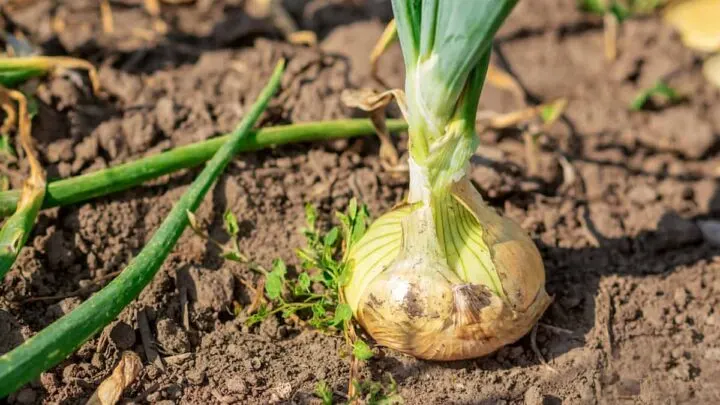One of my favorite things about growing onions is how big they get. Those nice, plump bulbs are a welcome sight for many gardeners, especially at harvest time. However, sometimes onions can look a little weird, and even have a thickness in their neck areas. This is something I’d always wondered about, so I decided to do some research into why onions have thick necks.
Onions have thick necks when there is too much nitrogen used in the growing process. This is particularly noticeable when nitrogen is administered too close to harvest. Onions with thick necks are also prone to spoiling and they don’t store well.
Although thick onions aren’t ideal for any gardener, it’s not all doom and gloom. In fact, you could make good use of them if you get to them soon enough.

Nitrogen’s Role In Thick Onion Necks
So, the most common reason an onion will have a thick neck is due to excess nitrogen. Nitrogens’ role in an onion plant is crucial, and onions are known for requiring a ton of it throughout the growing process.
However, when it’s given too much, it can cause the plant to come out with a poor structure overall. They won’t store well compared to thin neck plants. Much of this problem happens when the nitrogen is applied too late in the growing season.
As an onion develops, it requires a good amount of potassium and phosphorous; not just nitrogen Potassium is essential for strong root development. That’s how onions get a strong bulb.
However, keep in mind that’s just for the earlier stages of growth.
In general, onions prefer a balanced fertilizer. I would consider something with an NPK ratio with more phosphorus. I recommend using a balanced fertilizer with a ratio of 8-4-8 or 15-15-30.
When fertilizing the onions, do so every 2 – 3 weeks for best results. After the bulb starts to gain considerable size, you can stop and let it continue to grow, adding lots of water (trust time it’ll need it!).
Tips To Prevent Thick Necks In Onion Plants
Although thick-neck onions are common, even if you’re a seasoned gardener, it’s not the worst thing. There are a few steps you can take, simple ones that can prevent this from happening. It’s all about giving your onion what it needs in the right amounts and at the right times.

Fertilize At The Correct Time
Most of the time the fertilizer isn’t the problem, but it’s when you apply it. Most people want to grow large onions; but fertilizing at the wrong time can hinder that development.
Onions should fertilized a lot in the beginning stages, and then have that ferilizer applied every couple of weeks. A slow-release fertilizer high in nitorgen is good at first. However, as the bulb forms, and the plant matures, its time to pull way back on the feritlizer.
Some experts recomend seizing all ferilizing once the onion shows the bulb. I however find that it still needs a decnet amount of potassium so it forms a large, strong head.
Fertilizng at the wrong times not only leads to thicker necks, but it can cause other issues like:
- Splitting
- Leaf browning
- Delayed bulb development
- Poor storage
Nitrogen in particular can cause the bulb to delay developmet. Sure, the leaves will grow taller, but little is being done to develop the part we all want to eat.

Grow A Heat Treated Variety
For most onions, the growing season is late summer or early fall with the goal of harvesting by the spring or winter time.
However, when planting heat-treated onion sets, things are much different. Most of the time, you can plant those sets as late as April and harvest them in the Fall.
Heat-treated onions grow much faster, and the rapid pace is possible because of the entire heat-treating process. These onions are usually resistant to most diseases and pests, but the biggest benefit is that they rarely ever bolt.
Because they grow so quickly, you won’t need to fertilize them very much at all, so there’s less of a risk for excess nitrogen to be a problem. The bulb takes shape much more quickly and maintains its size and shape sooner.
Increase The Potassium
While nitrogen should be used with caution, its okay to add a bit more potassium to the soil as your bulb forms.
Here’s a great study on potassium rates and how it affects onion growth.
Rinse Out The Soil
Let’s say you ended up applying nitrogen too late by mistake, or you’re unsure of how much fertilizer is in the soil. No problem!
One step you can take right away is to rinse out the soil. This means giving it a deep watering so that the nutrients are rinsed out through drainage. This is something you can do periodically and is particularly helpful if you’re using a water-soluble fertilizer that needs to be rinsed out quickly.

Hi there, my name is Allie and welcome to my blog; GareningWithAllie!
Much of what you see written here is just our personal experiences with gardening. Along with the content I write here, there is also a unique collection of gardening topics covered by some of our close friends. I hope you find everything you read here to be helpful, informative, and something that can make your gardening journey the most lovely experience ever! With that said, Happy Gardening!
